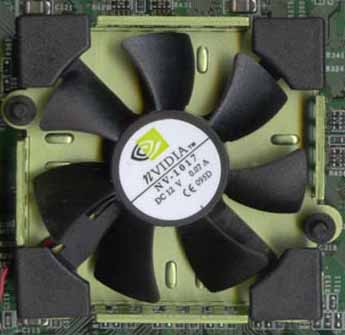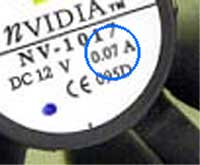Creative Labs Annihilator2 Ultra 64MB GeForce2 Ultra
by Anand Lal Shimpi on October 26, 2000 1:25 AM EST- Posted in
- GPUs
NVIDIA’s reference design called for an above average sized unit, which you can see in the picture below, however when we received ELSA’s GLADIAC ULTRA we noticed that they had implemented a different heatsink/fan. Let’s take a look at an excerpt from that review:
“In cooling this high clocked core, ELSA implemented an even larger heatsink/fan combo than what we saw on the reference Ultra board we received from NVIDIA in August. The heatsink measures 2” x 2” (5.08 cm x 5.08 cm), while the reference design heatsink was approximately 2.25” x 1.75”. The resulting surface area of the heatsink on the GLADIAC ULTRA is about 2% larger than what was present on the reference board, but that alone shouldn’t provide for a dramatic increase in cooling efficiency.
However, ELSA has also implemented a larger fan to go along with this larger heatsink. Instead of the 10 finned fan that spanned a diameter of 1.5” as we noticed on the reference board, ELSA implemented a fan with 7 larger fins and a full 2” diameter to aid in cooling the Ultra’s core. The two fans appear to spin at the same rate, meaning that ELSA’s fan should be effectively a better cooler than what we saw on the reference boards. “
Creative
Labs Annihilator2 Ultra/ELSA GLADIAC ULTRA

GeForce2
Ultra Reference Design

Upon further inspection, first noticed by AnandTech’s new Consumer Graphics Editor, Vlad Trishkin, the new fan, which is also used by Creative Labs actually draws less current than the one we saw on the reference board back in August. Both fans operate are rated at 12V, however the original reference design featured a 0.11A fan while the new fan is rated at 0.07 amps. This is over a 60% reduction in current, which should also translate into a slightly slower rotational speed for the new fan. However, since the fan is physically larger than the one we saw on the reference design, it should all balance out in the end.
|
Reference
Fan
 |
Creative
Labs/ELSA Fan
 |
Once again, the heatsink is attached to the GeForce2 Ultra core using thermal glue, which isn’t the best way to enhance heat conductivity however it is one of the easiest ways to do so on a production line without requiring human intervention.
The Annihilator2 Ultra features the same two heatsinks across the board’s memory chips that we’ve seen on both the original GeForce2 Ultra reference board and ELSA’s GLADIAC ULTRA. With the memory on the Annihilator2 Ultra running at 460MHz (230MHz DDR), it isn’t surprising to see a need for memory cooling. The heatsinks are attached using thermal glue and get relatively warm during normal operation.
When it comes to features, the Annihilator2 Ultra is nothing but a bare bones GeForce2 Ultra card. The board features no TV-out header, no VIVO features, no 3D glasses and doesn’t come with any sort of a game bundle. This should ideally help to kick the price of the card down a notch, but don’t expect to see it drop too far from the $500 price tag. We have seen stores advertising the Annihilator2 Ultra for around $430 - $460, which is under the $480 - $500 mark we’ve seen on the ELSA GLADIAC ULTRA, however you’re still talking about quite a bit of money for a video card.










0 Comments
View All Comments